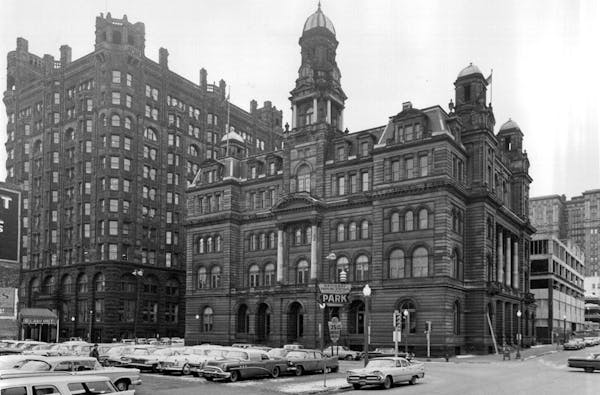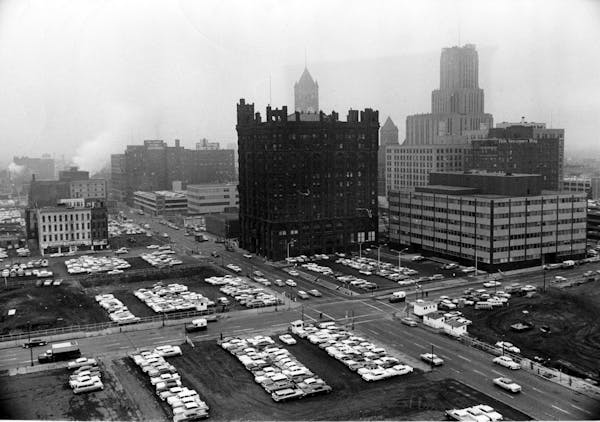When you drive down Main Street in a small town, you can always spot the building that used to be the bank.
It has columns and a pediment (that's the triangular wedge over the door). The architecture was supposed to tie the institution back to Rome, suggesting permanence and solidity.
Unfortunately, many of the banks were neither permanent nor solid.
When the Great Depression struck, many of the banks in small towns hit the canvas, leaving dead bank buildings. After that, construction of small-town banks seemed to shudder to a halt.
It wasn't until the go-go 1960s that banks started building again. The reasons are complex, and unimportant here (unless you really want to dive into the McFadden Act of 1927 or the Banking Act of 1933). The result was that the look of small-town banks changed.
The first banks in greater Minnesota tended to be late-19th-century Romanesque buildings — rough stone, perhaps a polished marble pillar on the corner by the angled entryway, a single carved word over the door: BANK.
It's the type of structure you see in old photos, with merchants standing outside looking serious and civic-minded. It's the type of building usually lost in the inevitable fire.
In the teens and '20s, the newly built banks were neoclassical in style, a midblock building, narrow, grave, with columns flanking a small door into which the depositor entered like a commoner petitioning Caesar.
The economic collapse of the '30s abetted the rise of new forms of architecture divorced from the old classics — lean, smooth designs that looked forward to a rational, machine-age culture. The World's Fairs of 1933 and 1939 cemented this as the look of things to come.
But few banks were built in the Moderne style. It was a fine look for a post office, because you wanted to believe your government was up-to-date. When it came to a place where you left your money, however, classic designs still had a powerful pull.
By the 1950s, many small-town banks were rehab jobs, russet marble over an old storefront. Sober and dull.
Then came the banking boom. Small towns — and suburbs, as well — saw new bank branches popping up. With few exceptions, they reflected the latest thinking in architectural design.
What a pity.
At best, this crop of buildings had some '60s flair.
Dark brick? Out. Sandy-hued brick? In.
Big windows? Out. Thin windows, like computer punch cards? In.
Unfortunately, most of those buildings didn't age well. They lacked the timelessness of the classic styles of the teens and '20s or the optimistic, technocratic look of the '30s. They were distinctive, though. And they served as a reminder that a small town's downtown wasn't dead, that the bank still had some faith. To this day, they're often the newest building in the town, even though they're half a century old.
There were some notable '60s branch bank designs, but the best of the bunch didn't show up outside of the Twin Cities.
We refer, of course, to Midwest Federal's abstract round banks. Tinted-glass structure was intended to look like a tree, which embodied the bank's logo and motto "A good tree to come to for shelter."
They popped up in the postwar suburbs starting in 1964. By the time the last one was built in 1973, there were eight little embassies of the future. Only the one in Golden Valley remains, and it's now a lighting outlet store.
It would be nice to think the last Midwest Federal tree bank could be saved, but it's difficult to convince people — and property owners — that kitschy commercial architecture from the '60s and '70s is historically significant.
When we think historical, we think of important looking buildings that helped to define a small town. But any bank — no matter what its style — helped define a town.
A town knew it was on the way up when it got a bank. Like a post office, it connected the town to the world beyond. The buildings that once housed banks may have other uses now, but they still look like banks. You have to cover them up or chisel off the facade to persuade anyone they're not.

Helen Simonson is in Jane Austen mode with 'The Hazelbourne Ladies Motorcycle and Flying Club'
It's Cinco de Mayo time, and festivities are planned across the US. But in Mexico, not so much
New Orleans' own PJ Morton returns home to Jazz Fest with new music


